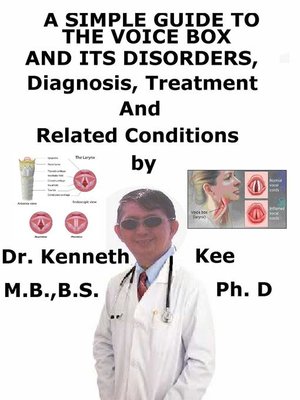A Simple Guide to the Voice Box and Its Disorders, Diagnosis, Treatment and Related Conditions
ebook
By Kenneth Kee

Sign up to save your library
With an OverDrive account, you can save your favorite libraries for at-a-glance information about availability. Find out more about OverDrive accounts.
Find this title in Libby, the library reading app by OverDrive.



Search for a digital library with this title
Title found at these libraries:
| Library Name | Distance |
|---|---|
| Loading... |
This book describes The Voice Box and Its Disorders, Diagnosis and Treatment and Related Diseases
"What is it about your voice that makes me want to hear you speak?"
— Ally Condie
The larynx or the voice box as it is often called is a complicated organ in the neck of humans which is involved in the breathing, sound formation and protection of the trachea from food aspiration.
The larynx comprises cartilages, ligaments, muscles and mucus membrane.
In the adult human body the larynx lies in front of the pharynx in the anterior neck at the point of the C3–C6 vertebrae.
It joins the inferior part of the pharynx with the windpipe (trachea).
The larynx contains the vocal cords which are vital for speech.
The vocal cords stays below where the tract of the pharynx separates into the trachea and the esophagus.
Function
The larynx mainly is an organ linked with vocalization and making sound.
Basically, when a person exhales, air is pushed through the glottis, and, it is the vibrations of the vocal cords that form the noise and sound.
During speech or vocalization, the positioning of these vocal cords alters to affect pitch and volume, which can be further controlled by the tongue and relative position of the mouth as required for speech.
Also, the larynx plays an important part in preventing food from being stuck in the airway.
When people swallow, the epiglottis moves downward, closing off the trachea.
The food or liquid then travels to the esophagus, which passes alongside the trachea, and delivers material to the stomach.
Diagnosis
Proper evaluation of the larynx is necessary to make sure of proper diagnosis of any disorder and overall function.
Mirror laryngoscopy:
This test that has been conducted for over a century involving the insertion of a special mirror into the back of the mouth to permit the specialist to visually assess the larynx.
Flexible fiberoptic laryngoscopy:
The most widely used flexible fiberoptic laryngoscopy involves the use of a tool termed an endoscope that is inserted through the nostril to obtain images of the interior of the larynx.
The testing is done as the patient swallows, talks, or sings to evaluate issues such as vocal cord paralysis or functional disorders due to neurological disorders, among others.
Rigid transoral laryngoscopy:
This type of laryngoscopy uses a rigid endoscope that has a light attached to it.
This tool's camera can capture high-quality images to the doctor and permits for more careful analysis.
It is utilized to diagnose subtler or less easily detected disorders in the larynx.
Stroboscopy:
This method requires the use of a specialized microphone that is placed on the skin just above the larynx.
This device detects the frequency of the voice and interprets it to a strobe light that flashes just out of sync with this frequency, producing a video image of the movement of the vocal folds.
This method is ideal for determining disorders of the health of the surface of the vocal cords, such as lesions.
The treatment methods for disorders that involve the larynx can depend on the diagnosis.
If the disorder has been produced by vocal abuse, misuse or overuse, the treatment might be as simple as the patient resting the voice for a small period of time.
The doctor might also advise rest and voice therapy to help full recovery.
The treatment methods for disorders that involve the larynx can depend on the diagnosis.
The treatment might be as simple as the patient resting the voice for a small period of time
TABLE OF...







